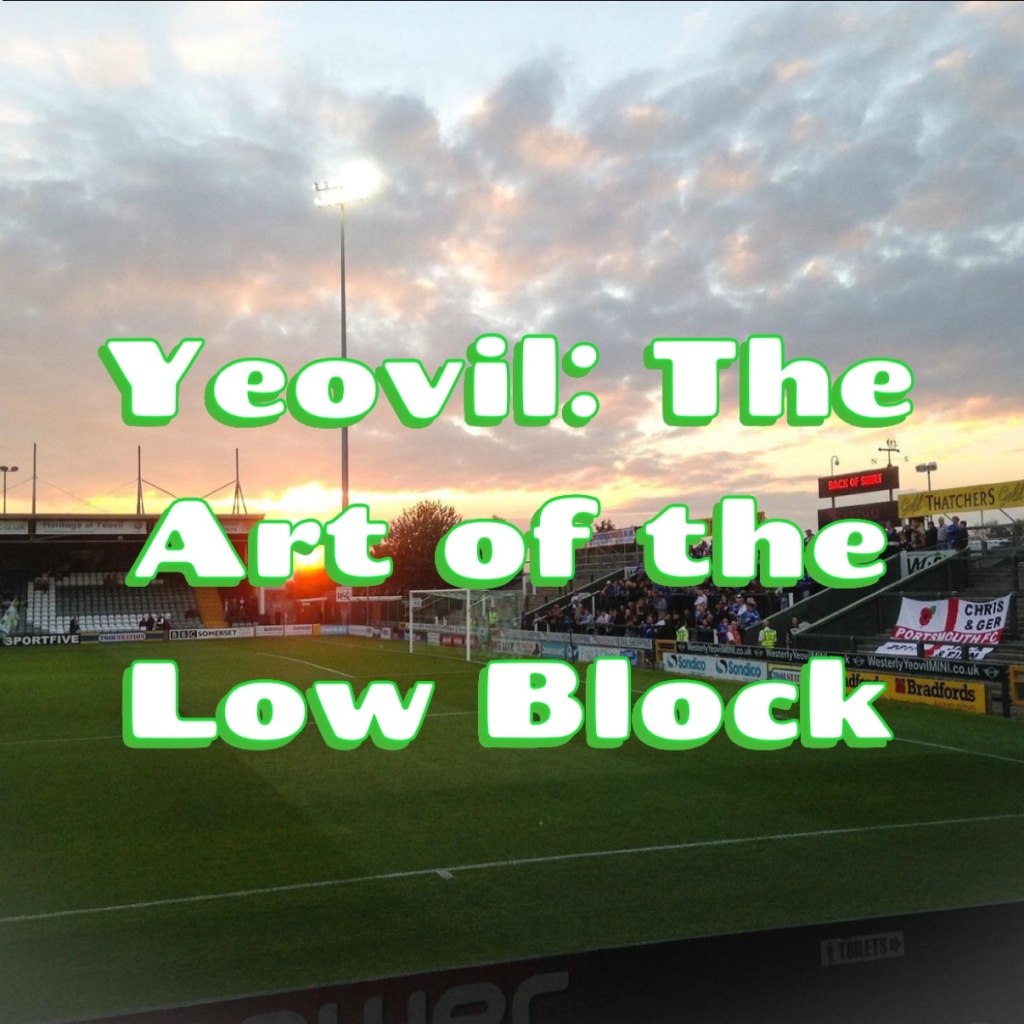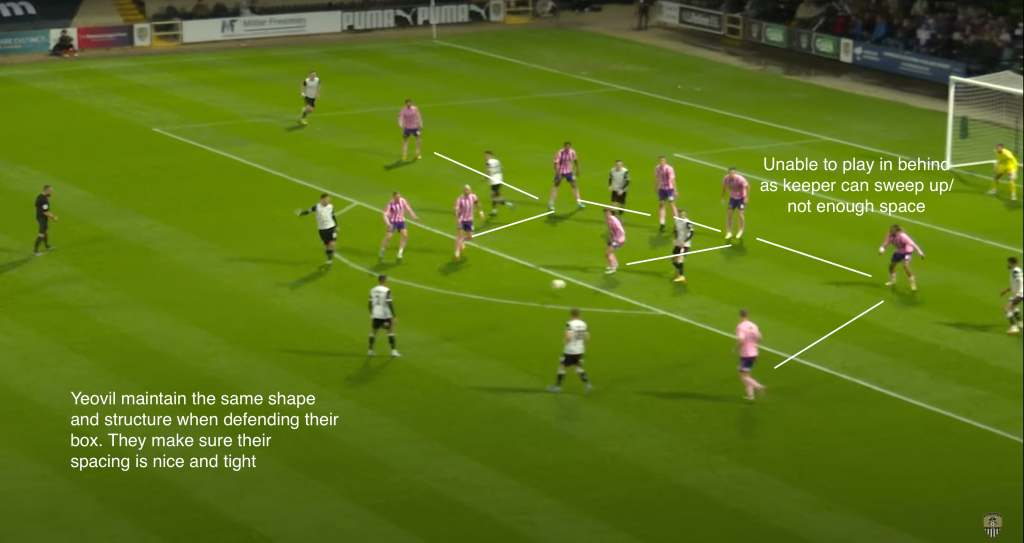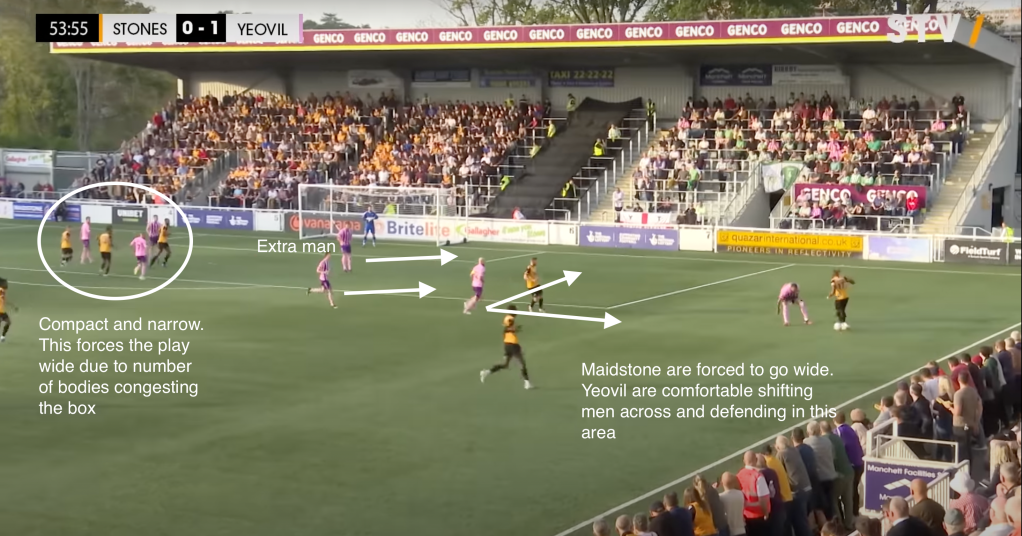
Some sides don’t go out to win football games, but instead go out not to get beat. Yeovil are one of those sides. They’ve drawn the most games in the league, a staggering 50% of their games (10 in 20), yet they sit just 2 points above the relegation zone. This is because they have won the fewest games this season too. So whilst they’ve only been beaten on 7 occasions, they don’t win a lot of games either. Their clean sheet and strong defensive performance at the weekend led me to consider; why is Yeovil’s low block so effective?
In order to answer the question I went back and analysed the 5 games boss Mark Cooper has been in charge for. I also chose a selection of games under previous coach Chris Hargreaves, mainly to see the similarities and differences between the two sides. Cooper has done very well, but he had a defensive foundation in place, values instilled in the players from the previous regime. I attempt to break down (pardon the pun) why their low block is so effective. In this piece I will examine team shape, how they set up, the personnel within the structure and other tactical nuances too.
Team Shape
Straight away from the picture below we can see that Yeovil have set up against County with a flat back 5, and then a bank of 4 straight in front of this. These are 2 flat, compact lines, and the spacing between the 2 is fairly decent, but close enough for the midfield to drop deep. Yeovil are not a side who squeeze out and press, but instead always look to retreat, so the spacing is ample to give the midfield time to get back. This shape leaves one striker up top (Alex Fisher) on his own. Yeovil have two pacy wide players in their midfield 4, who will aim to get up quickly to support Fisher. However, as I will examine later, Yeovil are actually a side who are fairly reluctant to attack. They certainly don’t like to commit numbers. This often leaves Fisher isolated, but with 9 men behind the ball any side is likely to be tough to break down, due to sheer numbers.

Yeovil also operate with a narrow shape too. The midfield 4 is especially narrow; there is almost no width at all in there. This compresses the game into the middle of the pitch, meaning often 15 or more players are in the same area. This makes life more difficult for the opposition, something which is achieved through team shape. Yeovil commit numbers to the central areas, sacrificing control on the flanks. This is done with one goal in mind; not conceding. Packing the central defensive areas of the pitch makes sense when you consider this is their game plan; after all the goal isn’t out on the touchline.
It is important to note that the above is an extreme example. Yeovil are facing County here, one of the best sides in the division. Here they completely sacrificed any forward output in order to maximise their defensive potential. However, the themes remain consistent, if not slightly tweaked. For example, against Woking they maintained their narrow shape, and still formed a low block, although the starting position of their low block was slightly higher. However, from the image below you can see the similarities. They remain extremely narrow, the spacing between each line very small. However, you can note the fact the wing backs are pushed on, something Cooper looks to do in games he feels Yeovil can snatch something in.

Defending from Deep
So we have established that Yeovil like to keep a compact defensive shape, and we also know that they like to retreat back. But why is it that they prefer to defend their own box? Strategically it provides them with a lot of advantages, despite the fact the opposition are closer to their goal. By being that close to the byline they only have to defend on 3 fronts, rather than 4. They still have to defend in front of them, and to the sides, but they no longer have to worry about balls in behind. For a limited outfit this allows them to refocus the effort defending in behind would require, and repurpose it elsewhere.
It also has a lot to do with the personnel at Yeovil’s disposal. I’ve made it no secret that I believe the quality of their playing squad, especially in the attacking third, is not up to the standard of this division. Whilst they are slightly stronger in defence, it isn’t packed with genuine quality. Their backline isn’t blessed with pace either, with 2 of the regular 5 over the age of 30. There is often a debate whether a manager should persist with a system if the players do not fit, or if they should craft a system to work around their players. In this instance there is a nice marrying of the 2; the Yeovil players have the experience to be organised, and therefore fit the ‘backs-to-the-wall’ type of defending.

When Yeovil don’t stick to this shape they get exposed with balls in behind; their defence are slow to turn, and at home, where they are slightly more positive in their outlook, they sometimes get caught out. The opening goal against Gateshead is a perfect example of this. Gateshead get Yeovil back pedalling, where they are really uncomfortable, and a simple ball clipped over the top sends Harris through for an easy 1 on 1.
By being deeper they do of course run the risk that the opposition are closer to goal. However, as we’ve already discussed, they are so compact in the box that getting any meaningful type of shot away is highly unlikely. Yeovil would be more likely to concede higher quality scoring chances from balls in behind if they leave the space there. By defending deep they invite pressure, but it’s pressure they’re willing to soak up. If someone scores from range, then so be it, but with a quality keeper like Grant Smith in goal it will take some strike to beat him from range.
The Keeper
It’s all well and good having a compact, defensive side that look to defend in their own box, but if you don’t have a reliable keeper all of the defensive effort would be in vain. Rather fortuitously for Yeovil, they happen to have one of the safest pairs of gloves in the division; Grant Smith. Smith has made 68 saves this season, with a save percentage of 76.4%. This is an incredible save percentage, the highest in the division (4 keepers actually have higher but they have all played 3 games or less). Clearly Smith is a supreme shot stopper, so the defence know that they are able to defend deep. They are bound to be confident in their keeper with statistics like that. Smith has also prevented 4.03 goals this season, the 3rd highest in the league. Clearly he performs well in the Glovers goal, which allows them to execute their defensive tactics. It’s also probable that Smith is aided by the system Yeovil employ; many of the shots he faces are of lower quality due to the shooting angles being blocked or reduced by the Yeovil defence.
Pressing
As discussed in team shape, Yeovil do not like to press. In fact, to the contrary, they actually allow the opposition to have the ball, instead looking to frustrate by maintaining good defensive shape. If they were to press they would risk losing their defensive shape; if they step out they will leave gaps in which the opposition will be able to run into. Defenders love to have the play in front of them, and not having to check their shoulders for runners; it allows them to concentrate on the task in hand, and maintain positioning. Runners can’t get in behind if there isn’t any space to run into, hence the decision not to press. This is evidenced by the fact they allow 10.55 Passes Per Defensive Action (PPDA). This is the 6th highest in the league, and it suggests they are quite happy for the opposition to have the ball. This is further supported by the fact that they record just 42.5% possession, the 2nd lowest in the league. Clearly they do not look to get on the ball, and instead focus on defensive solidity. They aren’t looking to play; rather they are looking to stop the opposition from playing.

Height Matters
It’s not an uncommon sight to see a manager who sees his side as limited to play more than 3 central defenders, often dropping a midfielder in order to accommodate an extra defender, and the extra solidity they provide. In Josh Staunton, Yeovil have done the same, pushing the central defender into midfield. Staunton has been an ever present, but at 5ft10 he isn’t the tallest of defenders. By pushing him forward, it not only gives the Glovers more solidity in midfield, but also allows them to select another taller defender at the back. Yeovil aren’t short (pardon the pun) on these tall options; Max Hunt is 6ft6 and Ben Richards-Everton is 6ft4. It may seem like a small thing (again pardon the pun) but this height really does help, at both ends of the pitch. We’ve established that Yeovil maintain a narrow, deep shape, making it difficult to play through the middle. Therefore, in order to beat their low block, sides are forced to play down the sides. This added height makes it that bit easier to defend the flanks, as once the ball comes in they are often favourite to win the headers based on sheer size alone.

At the other end of the pitch it’s a weapon too. When you couple in Alex Fisher, their 6ft4 striker, you already have a list of great options from set pieces. Their equaliser against Gateshead was a set piece, flicked into the back of the net by the aforementioned Fisher. As they defend so deep they are reliant on pacy wingers getting forward and winning fouls in the wide areas. They really lack any meaningful goal threat in open play, due to playing so deep, and lacking the necessary quality, so these set pieces really present themselves as very meaningful opportunities to score.
Where are the goals going to come from?
When Yeovil face well disciplined sides, or sides that are far superior on the ball, there is concern that they don’t have the firepower to get goals. Whilst I’ve been complimentary of their defensive structure and tactics, I do have to level some criticism at them as well. Whilst I understand they are making the most of their limited resources, there is a simple lack of goals in the side. They aren’t a threatening side. Whilst they did a masterful job in frustrating Notts County when they visited Meadow Lane, they mustered virtually no threat on the County goal. Whilst the result went their way on the day, in the long term it isn’t sustainable. They managed an xG of just 0.6, 0.57 of which came from one chance, and to be a side who score goals, and win games, you simply have to create meaningful scoring opportunities. It’s a problem that stretches over a far larger period than just the Notts County game though. Only Oldham have a lower xG than Yeovil in the league, and in terms of actual goals scored Yeovil are dead last, with just 16. Their defensive strength means they’ve only lost 7 games, but their weakness in their frontline also means they’ve won just 3 games, a divisional low.
So how do they attack when they are looking to score? They do deserve some credit in the attacking areas. They play to Alex Fisher’s strengths, and they have certainly looked to build their side, in the attacking phase at least, around him. When they aren’t putting the ball into the big forward, usually from left back Reckord, they are looking to get players as close to him as possible. Yeovil have a fair amount of pace in their side, namely in the likes of Oluwabori and Linton, and when they get the chance to break they often do so at speed. Whilst they are a side who restrict the opposition to attacking down the wings, they themselves are sometimes limited to playing out wide too.

There are 3 main issues they face in terms of scoring goals. Firstly, despite their pace, Yeovil’s support to Fisher is often far too withdrawn to get up the pitch in time. Secondly, due to their commitment to maintaining a strong shape, Yeovil are reluctant to commit men forward. If they did so it would leave them vulnerable to a counter themselves. This results in them being conservative in their attacks, and whilst it doesn’t leave them exposed, it also makes it extremely difficult for themselves to actually fashion any chances. The third, and perhaps most poignant reason, is a simple lack of quality. Fisher is a good target man, but perhaps passed his best and limited in what he can do. Outside of that, they do not have any true goalscorers. They lost Tom Knowles in the summer, who was their key attacker, and they haven’t really replaced him since. Left back Jamie Reckord is their 2nd top goalscorer, with 3 goals, and the other main striking option, Gime Toure, is a like for like replacement for Fisher. This makes them rather one dimensional. So whilst I commend their defensive shape, structure and organisation, their lack of attacking threat does concern me.

New Manager, Bright Future
The results former boss Chris Hargreaves produced weren’t fantastic, however, considering the issues we have just discussed in terms of personnel, the job he did was better than he got credit for. He laid the foundations for the way in which Yeovil now play, drilling into them the ethos that they must win as a collective, rather than a group of individuals. He had them well motivated, taking 4 points off of Chesterfield and Wrexham, 2 of the top 3 sides in the league. However, it must be said that under new boss Mark Cooper, Yeovil have looked massively improved. There is good reason that many feel his appointment was a massive coup.
For starters he has them more organised. Take the shape below against Wrexham under Hargreaves. Instantly you’ll notice the spacing between the midfielders is far larger than Cooper’s current version of the low block. There’s also far more space between the defence and midfield, and they are more spread across the pitch, defending with more width than they currently do. This allowed Wrexham to play through the lines far more easily than Notts did, so in this regard Cooper has improved them.

He also commits far less men forward than his predecessor did. This keeps Yeovil compact and in their shape. As we’ve already discussed, Yeovil now look to commit fewer men forward, as this leaves less in behind to be countered with. This just serves to make the current iteration of Yeovil even more solid. By being slightly more conservative in the attacking phase, Cooper has his men conceding fewer big chances. It’s the reason they were able to keep a clean sheet against Notts County, who at the time were league leaders.
Whilst I criticised Yeovil’s lack of attacking threat, it cannot be denied that Cooper has improved them in this regard too. I’m still not convinced by them going forward, but he has managed to get them to score more than 2 goals for the first time this season (in their 3-1 win over Gateshead), and he’s only been in charge for a month. Given extra time, Cooper may get the most out of his attackers. He’s done the right thing; ensured they continue to be tough to beat, and has made them even better at that. Once he is satisfied that they are solid he can begin to look at pushing them onto being a more threatening side. Cooper is a very good coach, and the fact a struggling Yeovil side have managed to lure him to be boss should provide Glovers fans with plenty of hope.
Conclusions
Mark Cooper has his Yeovil side paying immensely well. They are organised, committed and know their roles. Whilst they haven’t got the best squad in the league, they are currently one of the best collective units. It showed again at the weekend, with yet another clean sheet. They claimed a 1-0 victory over Halifax, which saw them rise up the table to 19th. Since Cooper has arrived Yeovil are 12th, with just 1 loss in those 6 games. Their tactics are very effective at the moment.
In my season preview I tipped Yeovil to go down, mainly based on the quality of their playing squad. I don’t think my assessment of their players is as particularly off; as individuals, Yeovil are completely uninspiring. However, the Glovers embody the age old cliche that football is a team sport; they are a side who are collectively strong, and by playing as a team they get results. They’ve had 2 coaches who I feel have done a very good job getting the best out of their players. They’ve had them well drilled, well organised and made them hard to beat. It’s therefore their tactics, management and will to win which has led me to saying I was wrong about Yeovil; I believe they will beat the drop.